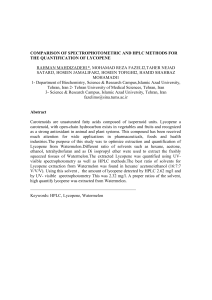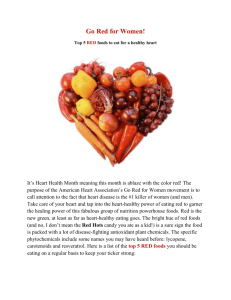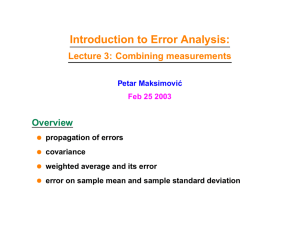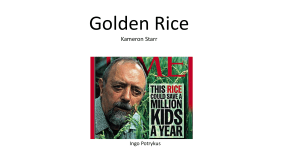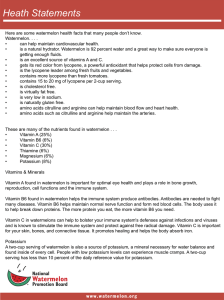In Search of High Lycopene Watermelon
advertisement
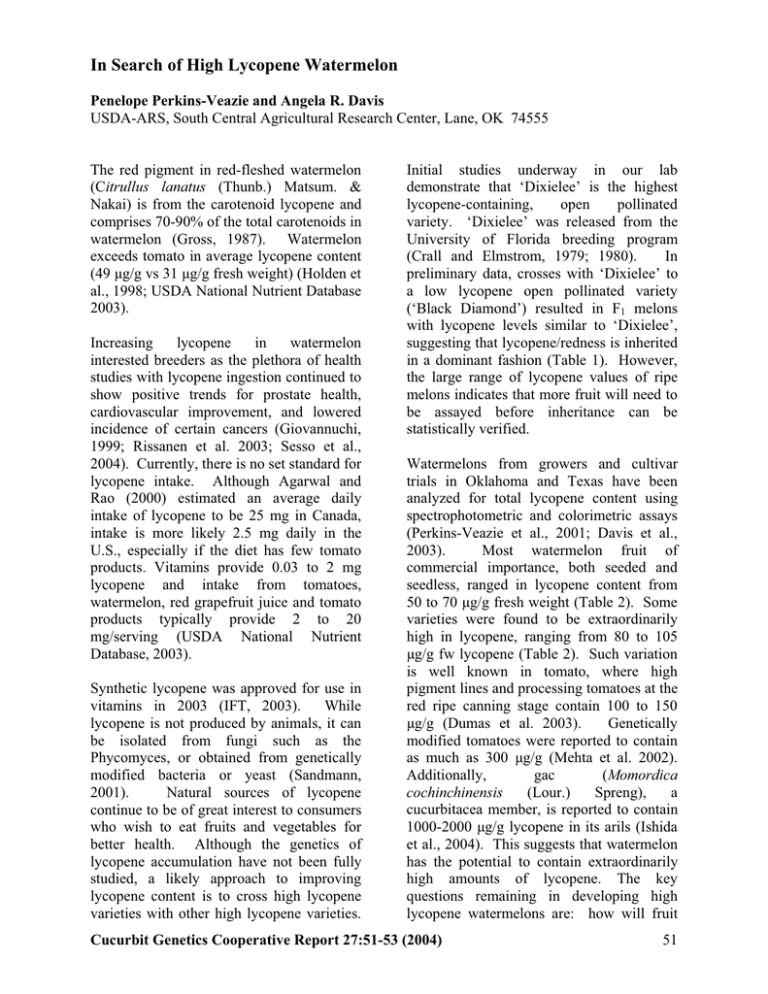
In Search of High Lycopene Watermelon Penelope Perkins-Veazie and Angela R. Davis USDA-ARS, South Central Agricultural Research Center, Lane, OK 74555 The red pigment in red-fleshed watermelon (Citrullus lanatus (Thunb.) Matsum. & Nakai) is from the carotenoid lycopene and comprises 70-90% of the total carotenoids in watermelon (Gross, 1987). Watermelon exceeds tomato in average lycopene content (49 µg/g vs 31 µg/g fresh weight) (Holden et al., 1998; USDA National Nutrient Database 2003). Increasing lycopene in watermelon interested breeders as the plethora of health studies with lycopene ingestion continued to show positive trends for prostate health, cardiovascular improvement, and lowered incidence of certain cancers (Giovannuchi, 1999; Rissanen et al. 2003; Sesso et al., 2004). Currently, there is no set standard for lycopene intake. Although Agarwal and Rao (2000) estimated an average daily intake of lycopene to be 25 mg in Canada, intake is more likely 2.5 mg daily in the U.S., especially if the diet has few tomato products. Vitamins provide 0.03 to 2 mg lycopene and intake from tomatoes, watermelon, red grapefruit juice and tomato products typically provide 2 to 20 mg/serving (USDA National Nutrient Database, 2003). Synthetic lycopene was approved for use in vitamins in 2003 (IFT, 2003). While lycopene is not produced by animals, it can be isolated from fungi such as the Phycomyces, or obtained from genetically modified bacteria or yeast (Sandmann, 2001). Natural sources of lycopene continue to be of great interest to consumers who wish to eat fruits and vegetables for better health. Although the genetics of lycopene accumulation have not been fully studied, a likely approach to improving lycopene content is to cross high lycopene varieties with other high lycopene varieties. Initial studies underway in our lab demonstrate that ‘Dixielee’ is the highest lycopene-containing, open pollinated variety. ‘Dixielee’ was released from the University of Florida breeding program (Crall and Elmstrom, 1979; 1980). In preliminary data, crosses with ‘Dixielee’ to a low lycopene open pollinated variety (‘Black Diamond’) resulted in F1 melons with lycopene levels similar to ‘Dixielee’, suggesting that lycopene/redness is inherited in a dominant fashion (Table 1). However, the large range of lycopene values of ripe melons indicates that more fruit will need to be assayed before inheritance can be statistically verified. Watermelons from growers and cultivar trials in Oklahoma and Texas have been analyzed for total lycopene content using spectrophotometric and colorimetric assays (Perkins-Veazie et al., 2001; Davis et al., 2003). Most watermelon fruit of commercial importance, both seeded and seedless, ranged in lycopene content from 50 to 70 µg/g fresh weight (Table 2). Some varieties were found to be extraordinarily high in lycopene, ranging from 80 to 105 µg/g fw lycopene (Table 2). Such variation is well known in tomato, where high pigment lines and processing tomatoes at the red ripe canning stage contain 100 to 150 µg/g (Dumas et al. 2003). Genetically modified tomatoes were reported to contain as much as 300 µg/g (Mehta et al. 2002). Additionally, gac (Momordica cochinchinensis (Lour.) Spreng), a cucurbitacea member, is reported to contain 1000-2000 µg/g lycopene in its arils (Ishida et al., 2004). This suggests that watermelon has the potential to contain extraordinarily high amounts of lycopene. The key questions remaining in developing high lycopene watermelons are: how will fruit Cucurbit Genetics Cooperative Report 27:51-53 (2004) 51 quality and flavor be affected (taste, sugars, firmness), how much lycopene can be produced by watermelon (e.g.100, 300, 500 µg/g fw), and will high lycopene fruit be a positive or a negative marketing factor for consumers (eg will high lycopene fruit cause health issues in consumers). Literature cited Agarwal, S., and A.V. Rao. 2000. Tomato lycopene and its role in human health and chronic diseases. Can. Med. Assn. J. 163:739-744. Crall, J.M. and G.W. Elmstrom. 1979. Dixielee, a round striped watermelon with intense red flesh and resistance to anthracnose and fusarium wilt. Fla. Agric. Expt. Sta. Cir. S-263, 1-9. Crall, J.M. and G.W. Elmstrom. 1980. 'Dixielee' watermelon. HortScience 15:99-100. Giovannucci, E. 1999. Tomatoes, tomatobsed products, lycopene, and cancer: review of the epidemiological literature. J. Natl. Cancer Inst. 91:317-331. Gross, J. 1987. Pigments in Fruits. Academic Press, p. 258. Institute of Food Technologists (IFT). 2003. BASF lycopene given GRAS. August 27, www.ift.org/cms Holden, J.M., A.L. Eldridge, G.R. Beecher, I.M. Buzzard, S.A. Bhagwat, C.S. Davis, L.W. Douglass, S.E. Gebhardt, D.B. Hayowitz, S. Shakel. 1999. Carotenoid content of U.S. foods: An update of the database. J. Food Comp. Anal. 12:16996. Dumas, Y., M. Dadomo, G. Di Lucca and P. Grolier. 2003. Effects of environmental factors and agricultural techniques on antioxidant content of tomatoes. J. Sci. Food Agric. 83:369-382. Ishida BK, Turner C, Chapman MH, McKeon TA. 2004. Fatty acid and carotenoid composition of gac (Momordica cochinchinensis (Lour.) Spreng) fruit. J Agric. Food Chem. 2004 Jan 28;52(2):274-9. Mehta, R.A., T. Cassol, N. Li, N. Ali, A.K. Handa, A.K. Mattoo. 2002. Engineered polyamine accumulation in tomato enhances phytonutrient content, juice quality, and vine life. Nat. Biotechnol. 20:613-618. Perkins-Veazie, P., J.K. Collins, S.D. Pair, W. Roberts. 2001. Lycopene content differs among red-fleshed watermelon cultivars. J. Sci. Food Agric. 81:983987. Rissanen, T.H., S. Voutilainene, K. Nyyssonen, R. Salonene, G. A. Kaplan, and J.T. Salonen. 2003. Serum lycopene concentrations and carotid atherosclerosis: the Kuopio ischaemic heart disease risk factor study. Am. J. Clin. Nutr. 77:133-138. Sandmann G. 2001. Carotenoid biosynthesis and biotechnological application. Arch Biochem Biophys. 385:4-12. USDA National Nutrient Database for Standard Reference, Release 16-1. 2003. [http://www.nal.usda.gov/fnic/ foodcomp/Data/SR16-1/sr16-1.html]. Cucurbit Genetics Cooperative Report 27:51-53 (2004) 52 Table 1. Initial inheritance study of lycopene accumulation using two open pollinated diploid watermelon with low (‘Black Diamond’) and high (‘Dixielee’) lycopene content (bc1=backcross of F1). Mean Lycopene Range of Number content Standard lycopene (µg/g) deviation (min/max) Cross of melons Black Diamond 46 33.06c 6.20 19.90-43.50 Dixielee 31 64.77a 12.84 38.94-93.12 F1 37 59.25ab 16.41 32.23-107.73 F2 25 55.05ab 11.32 32.19-81.47 bc1 x Black Diamond 7 50.12b 18.29 29.53-81.23 Means within column separated by Bonferroni t test, P<0.01. All melons in F1 and F2 crosses were red fleshed and all were used for lycopene analysis. Table 2. Lycopene content among red-fleshed watermelon varieties and seed company selections sampled from 1999 through 2003. Range of Mean lycopene Number of Lycopene content Std content melons (µg/g) dev (min/max) Variety Type sampled Sangria Diploid, Hybrid 475 52.54 8.23 38.90-80.40 Jamboree Diploid, Hybrid 20 61.06 5.08 52.75-71.39 Imagination Diploid, Hybrid 17 69.09 10.06 53.86-95.26 Summer Flavor 800 Diploid, Hybrid 123 72.78 8.78 61.96-91.88 Summer Flavor 710 Diploid, Hybrid 11 83.03 7.1 73.57-97.08 Tri-X-313 Hazera 6007 Hazera 6009 Sugar Baby 4N Millenium AllSweet Calhoun Gray Triploid Triploid Triploid Tetraploid Triploid 36 27 20 14 29 60.59 100.00 88.64 76.39 74.93 7.44 15.64 12.56 15.16 14.73 36.77-76.87 67.76-129.28 70.70-111.12 55.13-99.81 43.80-96.04 Diploid, Openpollinated Diploid, open pollinated 22 48.39 5.95 38.52-60.67 8 37.21 5.7 30.80-45.30 Cucurbit Genetics Cooperative Report 27:51-53 (2004) 53
